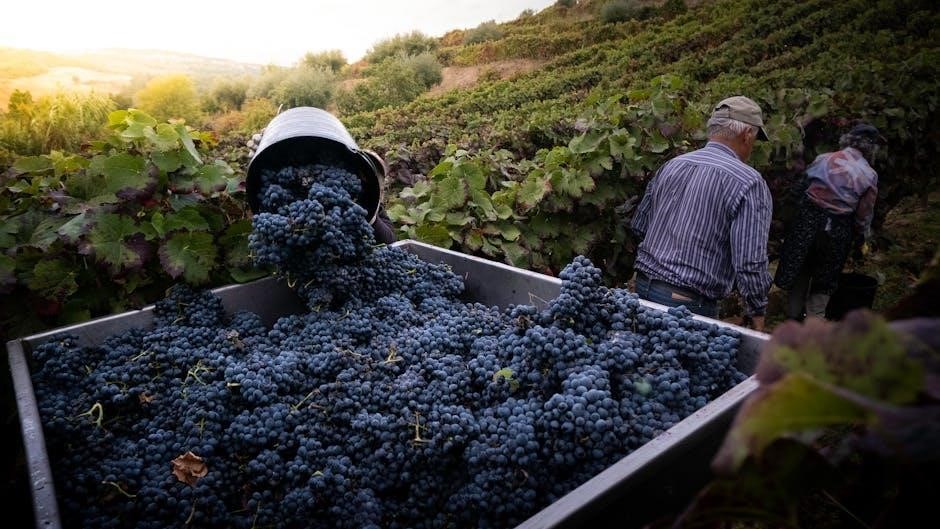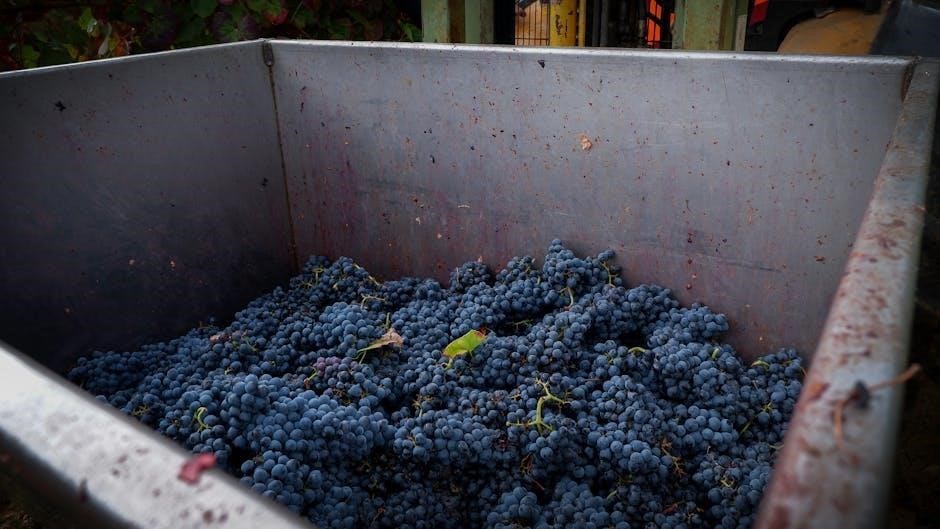Richard Betts, a master sommelier and author of The Essential Scratch and Sniff Guide to Becoming a Wine Expert, demystifies wine tasting with an approachable, playful method.
Who is Richard Betts?
Richard Betts is a master sommelier and renowned wine expert, author of The Essential Scratch and Sniff Guide to Becoming a Wine Expert. He simplifies wine tasting with an engaging, approachable method. Betts is one of fewer than 200 master sommeliers worldwide, yet he avoids wine jargon, making wine accessible to everyone. His innovative scratch-and-sniff guide introduces readers to wine basics through scent, empowering them to identify key flavors. Featured in major media, Betts demystifies wine, proving expertise doesn’t require pretentiousness. His work bridges the gap between wine enthusiasts and professionals, offering a fun, educational journey into the world of wine.
The Scratch and Sniff Method
Richard Betts’ Scratch and Sniff Method revolutionizes wine tasting with an innovative, hands-on approach, helping enthusiasts identify key scents and flavors in a fun, accessible way.
Overview of the Scratch and Sniff Approach
Richard Betts’ Scratch and Sniff Approach is a groundbreaking method that simplifies wine tasting by focusing on scent. Using scented cards, readers identify common wine aromas, such as citrus, floral, or earthy notes. This interactive tool helps develop the sense of smell, a critical skill in wine tasting. By breaking down wine into its basic components, the approach makes complex flavors accessible. The method encourages hands-on learning, eliminating the intimidation often associated with wine. It’s designed to be fun and engaging, allowing anyone to enhance their wine knowledge and confidence. This innovative technique demystifies the world of wine, making it approachable for all levels of enthusiasts.
Key Concepts in Wine Tasting
Key concepts in wine tasting include understanding tannins for structure, acidity for balance, and the role of scent in identifying flavors. These elements enhance the tasting experience.
Understanding Tannins and Acidity
Tannins and acidity are fundamental components in wine, shaping its structure and balance. Tannins, derived from grape skins, seeds, and oak aging, create a drying sensation, adding complexity. Acidity, meanwhile, contributes freshness and vibrancy, often compared to the crispness of citrus. Together, they create harmony, with tannins providing depth and acidity lifting flavors. Richard Betts emphasizes these elements as essential for understanding a wine’s character. Balancing tannins and acidity is key to a wine’s overall appeal, ensuring it feels both robust and refreshing. These concepts are crucial for appreciating wine’s nuances and enhancing the tasting experience.
The Importance of Scent in Wine
Scent is a critical element in wine tasting, often considered the gateway to understanding a wine’s character. Richard Betts highlights that the aroma can reveal much about a wine’s origin, grape variety, and aging process. By identifying specific scents, such as floral, fruity, or earthy notes, one can better grasp the wine’s complexity. Betts’ approach encourages learners to trust their sense of smell, as it is inherently intuitive. The nose often detects nuances the palate misses, making scent a powerful tool for enhancing the tasting experience. Mastering scent recognition is a foundational skill in Betts’ method, helping to demystify wine and make it more accessible.
Essential Wine Tools
Wine glasses and decanters are vital tools for enhancing the tasting experience. Glasses shape aroma and flavor, while decanters aerate wine, revealing its full potential.
Wine Glasses and Decanters
Proper wine glasses and decanters are essential for enhancing the tasting experience. Glasses are designed to direct aromas to the nose and flavors to the palate, with shapes varying by wine type. A Bordeaux glass, for example, is taller and wider to capture bold red wine aromas, while a Burgundy glass is broader to emphasize delicate nuances. Decanters, meanwhile, serve to aerate wine, softening tannins and releasing complex flavors, especially in older or robust wines. Using the right tools isn’t about pretension—it’s about respecting the wine and the craft behind it, ensuring every sip is savored to its fullest potential.

Major Wine Regions
Major wine regions include Old World areas like France, Italy, and Spain, and New World regions like Napa Valley, Argentina, and Australia. Each region’s terroir shapes wine flavor profiles and winemaking techniques, offering unique tasting experiences.
Old World vs. New World Wines
Old World wines, from regions like France, Italy, and Spain, emphasize terroir and traditional winemaking. They often feature earthy, nuanced flavors with higher acidity and tannins. New World wines, from areas like California, Australia, and Argentina, focus on bold fruit flavors and modern techniques. These wines tend to be richer and more approachable. Richard Betts highlights these distinctions, helping readers understand how regional differences shape wine profiles. Both styles offer unique tasting experiences, reflecting their origins and winemaking philosophies. This contrast is key to exploring the diversity of global wines.

Wine and Food Pairing
Richard Betts simplifies wine and food pairing by focusing on complementary flavors and textures. He emphasizes matching wine intensity with dishes, ensuring harmony and balance at the table.
Basic Principles of Pairing
Richard Betts advocates for a straightforward approach to wine and food pairing, focusing on balance and harmony. He suggests matching the intensity of the wine with the dish, ensuring neither overpowers the other. Complementary flavors, such as pairing crisp whites with seafood or bold reds with red meat, are key. Texture and acidity also play roles, as acidic wines cut through richness, while tannic wines complement fatty or hearty dishes. Betts encourages simplicity, advising to trust personal taste and explore pairings without rigid rules. This approach makes wine pairing accessible and enjoyable for novices and experts alike, fostering confidence and curiosity.

Common Mistakes to Avoid
Overcomplicating wine choices and blindly following trends are common pitfalls. Trust your palate, avoid rigid rules, and keep pairing simple for a more enjoyable experience.
Overcomplicating Wine Choices
One of the most common mistakes wine enthusiasts make is overcomplicating their selections. Richard Betts emphasizes that wine should be approachable and enjoyable, not a source of stress. Many people get caught up in trying to pair wines “perfectly” with food or adhering to strict rules about grape varieties and regions. Betts argues that this mindset can lead to missed opportunities for exploration and pleasure. Instead, he encourages drinkers to trust their palates and focus on balance and personal preference. By simplifying the process and embracing experimentation, wine becomes more accessible and fun. Remember, the goal is to enjoy the experience, not to impress others.

Resources for Further Learning
Explore Richard Betts’ book, The Essential Scratch and Sniff Guide to Becoming a Wine Expert, and platforms like Vivino for further wine learning and exploration.
Recommended Books and Online Platforms
For deeper wine knowledge, Richard Betts’ The Essential Scratch and Sniff Guide to Becoming a Wine Expert is a must-read. Online platforms like Vivino offer ratings and reviews to help users discover wines. Wine Spectator provides educational articles, while apps like Drync simplify wine exploration. Websites such as The Wine Economist and YouTube channels like Wine Folly also offer engaging content. These resources cater to both beginners and enthusiasts, making wine education accessible and enjoyable. Explore these tools to enhance your understanding and appreciation of wine.
Richard Betts’ approach to wine tasting and education has revolutionized the way people understand and enjoy wine. By emphasizing simplicity and accessibility, he encourages everyone to explore the world of wine without intimidation. His innovative methods, such as the Scratch and Sniff approach, make complex concepts easy to grasp. Betts’ philosophy centers on personal preference and the joy of discovery, reminding us that wine is meant to be savored and shared. Whether you’re a novice or an enthusiast, Betts’ guide offers a comprehensive yet approachable pathway to wine expertise. Embrace the journey, and let your senses guide you to new experiences.